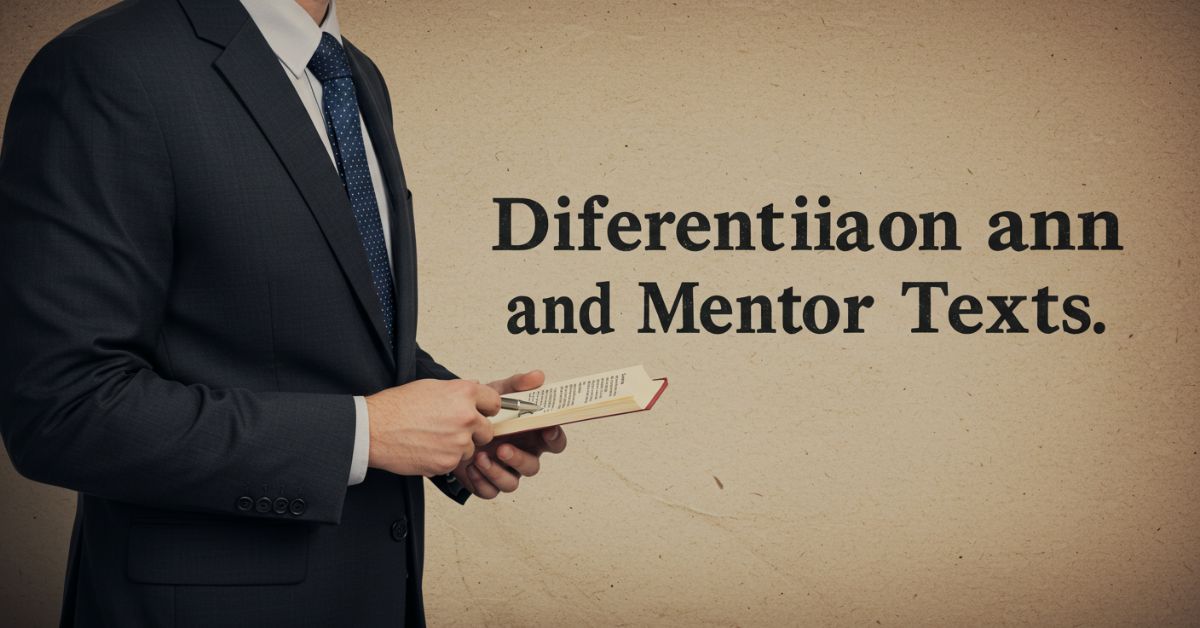Every student is unique, with their own set of strengths, interests, and challenges. In a world where education often follows a one-size-fits-all approach, differentiation has emerged as an essential strategy for unlocking the potential in every learner. Imagine if you could tailor your teaching to meet each student’s individual needs while still maintaining engagement and excitement in the classroom.
That’s where mentor texts come into play. These powerful tools serve as exemplars that can inspire students across various skill levels and learning styles. They offer opportunities for connection and exploration within lessons, making them invaluable for differentiated instruction.
In this blog post, we’ll dive deep into how mentor texts can transform your teaching approach. Get ready to discover strategies that will empower both you and your students on the journey towards academic success!
Contents
- 1 Understanding Differentiation in Education
- 2 The Importance of Mentor Texts in Differentiating Instruction
- 3 Choosing the Right Mentor Texts for Your Classroom
- 4 Strategies for Using Mentor Texts to Meet Individual Student Needs
- 5 Case Studies: Success Stories of Differentiation with Mentor Texts
- 6 Overcoming Challenges and Implementing Differentiation Through Mentor Texts
- 7 Empowering Students Through Differentiated Instruction with Mentor Texts
- 8 Conclusion:
Understanding Differentiation in Education
Differentiation in education is all about recognizing and responding to the diverse needs of students. It involves tailoring instruction to accommodate varying abilities, interests, and learning preferences.
Every classroom is a mosaic of learners. Some may grasp concepts quickly, while others need more time or different strategies to understand the same material.
Effective differentiation ensures that every student has access to meaningful learning experiences. This can mean adjusting content, processes, or products based on individual needs.
Teachers play a crucial role in this process. By observing students closely and understanding their unique challenges and strengths, educators can create a supportive environment where everyone thrives.
The goal isn’t just academic success; it’s fostering a love for learning that lasts well beyond the classroom walls. When done right, differentiation paves the way for each learner’s potential to shine brightly.
The Importance of Mentor Texts in Differentiating Instruction
Mentor texts serve as powerful tools in the classroom. They offer students a tangible model of quality writing and creativity. This is especially vital when differentiating instruction.
By presenting various genres, styles, and perspectives, mentor texts cater to diverse learning needs. Students can relate to different authors and find their unique voices through these examples.
Moreover, mentor texts spark inspiration for personal expression. When learners see how others convey ideas, they are encouraged to experiment with their own writing.
Using these resources also fosters rich discussions among peers. Conversations about themes or techniques deepen understanding while promoting collaboration.
In essence, mentor texts create an inclusive environment where every student feels valued. They bridge gaps in knowledge and skills, allowing individualized growth without isolating any learner from the group dynamics.
Choosing the Right Mentor Texts for Your Classroom
Selecting the right mentor texts is a crucial step in effective differentiation. It’s essential to consider the diverse needs of your students. Look for texts that resonate with various reading levels and interests.
Think about themes that connect with real-life experiences. When students relate to what they read, their engagement flourishes. Incorporate a mix of genres—poetry, fiction, non-fiction—to cater to different learning styles.
Don’t forget about cultural relevance. Texts that reflect the backgrounds and identities of your students can foster inclusivity and understanding. This connection boosts motivation and encourages deeper discussions.
Involve your students in the selection process when possible. Their input can guide you toward materials they find intriguing or inspiring, creating a sense of ownership over their learning journey.
Strategies for Using Mentor Texts to Meet Individual Student Needs
Using mentor texts can transform instruction by catering to diverse student needs. Start by selecting a range of texts that vary in complexity, genre, and themes. This variety allows students to engage with material suited to their interests and reading levels.
Incorporate guided discussions around the chosen texts. Encourage students to analyze style, structure, and voice. This enhances comprehension and develops critical thinking abilities.
Consider pairing students strategically for collaborative work on projects involving mentor texts. Peer interactions often lead to richer insights and promote a supportive learning environment.
Utilize writing prompts inspired by mentor texts as differentiated assignments. Allow students the freedom to choose topics that resonate with them while applying learned techniques from the text.
Consistently reflect on student progress through assessments tailored around these tasks. Adjustments based on individual performance will help ensure every learner feels supported in their journey towards mastery.
Case Studies: Success Stories of Differentiation with Mentor Texts
One teacher introduced mentor texts to a diverse fifth-grade class. She selected various genres, allowing students to connect personally with the material. Engagement soared as they found relatable voices in poetry and narratives alike.
Another case involved a high school English classroom. A teacher utilized mentor texts tailored for different reading levels, fostering inclusivity among advanced and struggling readers. Students collaborated on projects that highlighted key themes, enhancing their critical thinking skills.
In yet another instance, an elementary educator used picture books as mentor texts for writing workshops. The visual elements inspired reluctant writers to express themselves creatively. They transformed their ideas into vibrant stories.
These examples illustrate how mentor texts can bridge gaps in understanding and inspire all learners, regardless of their starting point in literacy journeys. Each success story reinforces the power of differentiation through thoughtfully chosen materials.
Overcoming Challenges and Implementing Differentiation Through Mentor Texts
Implementing differentiation with mentor texts can present hurdles, but overcoming these challenges is possible. One common issue is varying reading levels within a classroom. Using a range of mentor texts allows educators to cater to diverse abilities.
Another challenge lies in time constraints. Teachers often juggle multiple responsibilities, making it difficult to plan differentiated lessons. Streamlining the selection process for mentor texts can help save valuable prep time while still meeting student needs.
Professional development can also play a crucial role. Collaborating with colleagues enhances understanding and generates new ideas for using mentor texts effectively. Workshops or discussion groups provide opportunities for sharing strategies that have worked in different contexts.
Collecting feedback from students fosters growth and adaptation. Listening to their experiences encourages continuous improvement of instructional practices tailored through well-chosen mentor texts, ensuring all learners thrive in their educational journey.
Empowering Students Through Differentiated Instruction with Mentor Texts
Empowering students isn’t just about delivering content; it’s about connecting with each learner’s unique needs. Mentor texts are a powerful tool in achieving this goal.
When teachers incorporate diverse mentor texts, they open doors to different perspectives and writing styles. This variety allows students to see themselves reflected in the literature, boosting confidence and engagement.
Using mentor texts encourages creativity. Students can analyze structure and voice while developing their own ideas. They’re not merely absorbing information; they’re actively participating in the learning process.
Mentor texts also facilitate meaningful discussions among peers. These conversations help students articulate their thoughts and refine their understanding of complex concepts.
By tailoring instruction around these resources, educators create an inclusive environment where every student feels valued. The result is a classroom buzzing with enthusiasm as learners discover their potential through differentiated pathways.
Conclusion:
Differentiation in education is not just a strategy; it’s an essential approach to unlock every student’s potential. By integrating mentor texts into the learning environment, teachers can tailor their instruction to meet diverse needs. These texts serve as powerful tools that inspire creativity and critical thinking while providing relatable examples.
Selecting the right mentor texts requires careful consideration of students’ interests, reading levels, and cultural backgrounds. This thoughtful curation enhances engagement and fosters a love for learning.
Employing strategies like guided discussions, writing workshops, or small group analyses allows educators to leverage these texts effectively. Each student can connect with the material in ways that resonate personally.
Success stories abound where differentiation through mentor texts has transformed classrooms. Students who previously struggled begin to thrive when they feel seen and supported through tailored resources.
While challenges exist—such as time constraints or varying levels of student readiness—the rewards are significant. Educators have the power to overcome obstacles by remaining flexible and creative in their approaches.
Empowering students means recognizing their unique paths toward understanding and growth. With differentiated instruction anchored in meaningful mentor texts, we pave the way for all learners to succeed on their educational journeys.
Ethan Cole is a versatile writer at hsnime.co.uk, offering fresh perspectives and engaging content across various topics. With a passion for creativity and knowledge, Ethan aims to provide insightful articles that resonate with a diverse audience.






